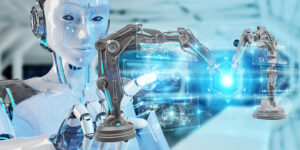Robotics and Automation: Shaping a World of Efficiency and Possibilities
Introduction
The rise of robotics and automation has heralded a new era of technological advancements that are transforming industries, reshaping economies, and redefining the way we live and work. With rapid progress in artificial intelligence, machine learning, and sensor technologies, robotics, and automation are unlocking a world of efficiency, precision, and boundless possibilities. In this article, we explore how robotics and automation are impacting various sectors and the potential implications for the future.
- The Emergence of Robotics: A Leap Forward in Innovation
Robotics, once confined to the realm of science fiction, has evolved into a tangible reality. Robots, powered by sophisticated algorithms and sensors, are now capable of mimicking human movements and performing complex tasks with exceptional accuracy. From manufacturing to healthcare, agriculture to space exploration, robots are stepping into roles that enhance productivity and safety.
- Automation: The Pursuit of Efficiency and Streamlined Processes
Automation, enabled by robotics and artificial intelligence, is driving an unprecedented wave of efficiency across industries. Repetitive and mundane tasks that once required human intervention are now automated, allowing human workers to focus on more creative and strategic aspects of their jobs. This boost in productivity is revolutionizing supply chains, logistics, and manufacturing processes worldwide.
- Robotics in Healthcare: Advancing Patient Care and Surgery
In the field of healthcare, robots are playing a pivotal role in diagnostics, treatment, and surgical procedures. Surgical robots, guided by skilled surgeons, offer enhanced precision and dexterity, leading to reduced recovery times and improved patient outcomes. Additionally, robotic assistants are aiding in patient care, rehabilitation, and eldercare, easing the burden on healthcare professionals and enhancing the quality of life for patients.
- Automation in Agriculture: Feeding the Future
With a growing global population and limited arable land, automation has become a critical factor in ensuring food security. Autonomous drones and robotic machinery are revolutionizing farming practices, optimizing irrigation, monitoring crop health, and facilitating efficient harvesting. By combining data analytics and AI, automation in agriculture holds the key to sustainable and high-yield farming.
- Robotics in Education: Transforming Learning Experiences
In the realm of education, robotics is transforming learning experiences and engaging students like never before. Educational robots are used to teach programming, problem-solving, and creative thinking, nurturing the next generation of innovators and technologists. Furthermore, robots with AI capabilities can provide personalized learning experiences tailored to individual student needs.
- The Future of Work: Collaboration between Humans and Robots
As robotics and automation advance, concerns about job displacement often arise. However, the future of work lies in collaboration between humans and robots. While automation may replace some jobs, it will also create new opportunities in fields like robot maintenance, programming, and system design. By augmenting human capabilities, robotics can lead to a workforce that is more skilled, efficient, and adaptive.
Conclusion
Robotics and automation have transcended the realm of science fiction to become a transformative force driving progress across industries. With unprecedented precision, efficiency, and the ability to handle hazardous tasks, robots are reshaping the way we work and live. Embracing the potential of robotics and automation will unlock a world of new possibilities, fostering innovation, and propelling humanity towards a future where collaboration between humans and machines will redefine the limits of what we can achieve. As we navigate this technological revolution, it is crucial to strike a balance between embracing automation’s benefits while addressing societal challenges to ensure a future that benefits all of humanity.
